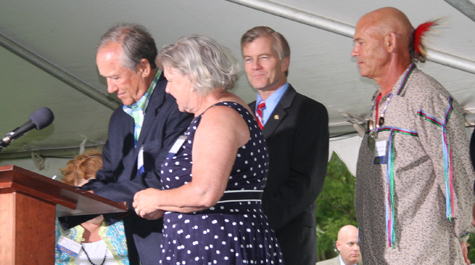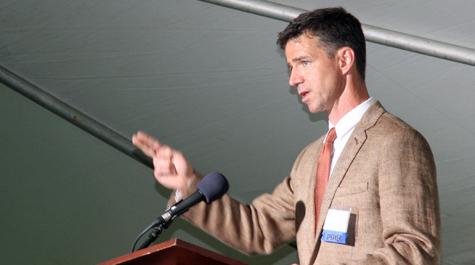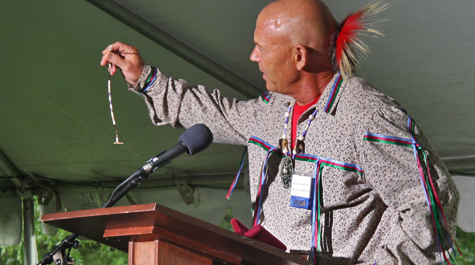Werowocomoco ceremony: America didn’t begin in 1607
One point was made over and over again at the June 21 ceremonial signing of a conservation easement to protect Werowocomoco: American history did not begin with the 1607 landing of the Jamestown settlers.
The point was made by many of the speakers at a gathering to witness the signing of a conservation easement to protect the site of Werowocomoco, the capital city of Paramount Chief Powhatan. The event sealed an agreement between the Virginia Department of Historic Resources and landowners Bob and Lynn Ripley, to preserve the site from disturbance or development.
Virginia Governor Bob McDonnell and U.S. Rep. Rob Wittman and other officials gathered at the site outside Gloucester, joining with archaeologists and representatives of the seven tribes of Virginia Indians that carry ancestral and cultural links to Werowocomoco to talk about the site as “a place of power” and to assert its proper place in the history of North America. William & Mary faculty were cited as major contributors to the new understanding of Werowocomoco’s importance.
{{youtube:medium:left|0H8MHu1T3G0}}
“The archaeological discoveries and attendant interpretation of the Werowocomoco Research Group, led by Dr. Martin Gallivan, ripped to shreds the Anglo-centric term ‘pre-history’ as it relates to the history of this land and its indigenous people prior to the arrival of the invaders in 1607,” Stephen R. Adkins, chief of the Chickahominy Indian Tribe, told the crowd that overflowed a large pavilion tent on the afternoon of the summer solstice. “Today we honor the polity, social order, economic enterprise, religious customs, agricultural prowess, engineering feats and craftsmanship of our ancestors.”
Gallivan, associate professor of anthropology at William & Mary, led the archaeological examination of Werowocomoco, the long-hidden capital city of Powhatan and his ancestors. Several speakers at Coming Home to Werowocomoco praised the decision of the Werowocomoco Research Group, based at William & Mary, to involve Virginia Indians in the excavation of the site through establishment of the Indian Advisory Board. Several Indians participated in the excavation as well, including Ashley Atkins, a Pamunkey who was one of the speakers at the Coming Home to Werowocomoco event.
“Werowocomoco, unlike other significant native places in the country, has retained its indigenous character,” said Atkins, who is a Ph.D. candidate in William & Mary’s anthropology program. “Creation of an easement at this archaeological site will undoubtedly ensure that this character remains.”
Gallivan and VDHR archaeologist Randolph Turner gave overviews of the discovery and excavation of Werowocomoco. Turner noted that his first visit to the site was in the 70s, while Gallivan recognized his fellow members of the Werowocomo Research Group, which includes Turner and archaeologists Thane Harpole, Dave Brown and Danielle Moretti-Langholtz, director of the American Indian Resource Center at William & Mary.
Gallivan gave a rundown of the archaeological discoveries at Werowocomoco, highlighted by evidence of a large longhouse that he believes was the residence of Chief Powhatan himself. He explained that archaeological evidence such as carbon dating of posthole remains, the age and the size—roughly four times the size of a normal Indian house of the period— corresponded with Colonial-era descriptions of the house.
“Chief Powhatan received the Jamestown colonists several times in a house very much like this one,” Gallivan said. “John Smith’s legendary rescue by Pocahontas evidently occurred there. Of course the story of Pocahontas’s rescue of John Smith has become part of the American origin myth. In fact, we don’t know whether the rescue story truly happened—but if it did occur, it probably took place within this house.”
He went on to say that his investigations have led him to understand that Werowocomoco is more important than a location for part of the Pocahontas myth. Gallivan noted that site is greater than Powhatan himself. The city was a place of power for hundreds of years before the birth of Wahunsenacawh, Powhatan’s real name.
The Virginia officials—which included Virginia State Senator Tommy Norment and Virginia House Delegates M. Keith Hodges and Douglas Domenech, Virginia’s secretary of natural resources—all spoke of the historical and cultural importance of Werowocomoco, as did DHR Director Kathleen Kilpatrick, who brokered the conservation easement with the Ripleys. Wittman drew applause from all Virginians in the overflow crowd—Indian and non-Indian alike—when he called for advancement of federal recognition of the Virginia tribes.
“We have a moral obligation,” he said, “to make this happen.”
McDonnell said that the ceremony marked a wonderful day in the 406-year history of Virginia, as dated from the landing at Jamestown.
“But the chiefs that are here, the seven of them, know it goes back for hundreds and perhaps thousands of years before that,” he said, nodding to the front row, where the Powhatan tribes were represented by their leaders, including Chief Kevin Brown, of the Pamunkey; Chief Mark “Falling Star” Custalow, of the Mattaponi; the Chickahominy’s Stephen R. Adkins; Gene “Pathfollower” Adkins, of the Chickahominy Eastern Division; Chief G. Anne Richardson, of the Rappahannock; and Chief Kenneth Adams of the Upper Mattaponi. Members of the Nansemond were also present, although Chief Barry Bass was unable to attend.
The governor asked the gathering of more than 300 to try to become attuned to the sense of place of the site on what we now call Purtan Bay.
“Can you sense, as you sit here on the banks of this beautiful river, Chief Powhatan going out with members of his tribe to visit one of those 30-some tribes that he was responsible for, from this cultural and economic center?” Governor McDonnell asked. “Can you kinda see John Smith coming off the boat to have his one and only meeting with the chief back in December of 1607?”
The site was identified in 2003 as the political center of Powhatan’s extensive Tidewater chiefdom, which stretched from the Potomac to south of the James and from the Eastern Shore to the fall line near today’s I-95. Since 2003, archaeological work by Gallivan and others has confirmed the site’s identity as Werowocomoco.
 Skip to main content
Skip to main content




